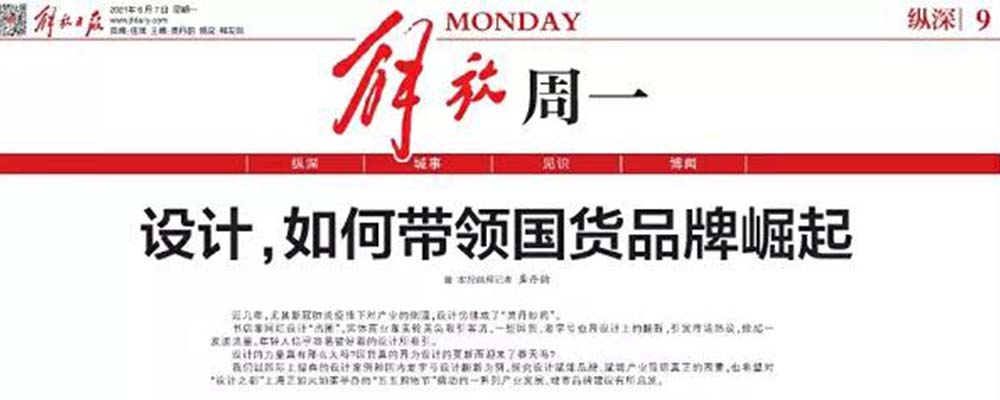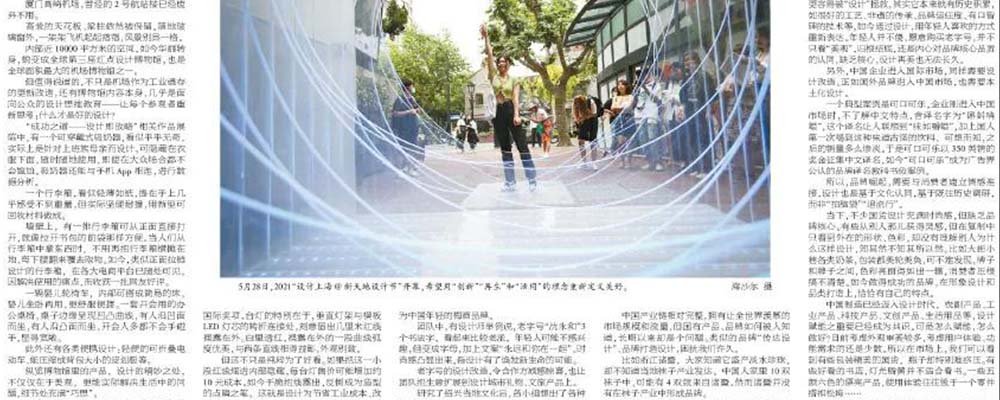


Jiefang Daily's Interview with Florin Baeriswyl
Gong Danyun, chief correspondent of the Jiefang Daily, interviewed the Swiss Professor Florin Baeriswyl on the topic of branding and design, which is part of the theme "Shanghai Design@New Heaven and Earth Design Festival."
The 'Brand Strategy and Management' (BSM) major was created by Professor Florin Baeriswyl. Launched in 2013 at DeTao SIVA University Shanghai, this bachelor's degree combines advanced methodologies and case studies with global brands' experiences and practical knowledge to develop talents in the industry.
The following article is from Jiefang Daily-Jiefang Monday column
Headline:Can Domestic Design create Brand Value?
Chief Correspondent: Gong Danyun
Coming from a country known for quality - Switzerland - Professor Florin Baeriswyl is able to provide a holistic view on brands and their value development and how innovation can be created. Florin Baeriswyl, who has designed several Swiss and international brands, knows how to define the brand values, thus strengthening brand messages and specifying the positioning so that a company presents itself prosperously.His credo: A brand is defined by quality, consistency and uniqueness - the design reflects the brand values.
He has helped clients as diverse as e.g. Nestlé, Swiss Air, USM, Red Bull and Deutsche Bank
.Florin Baeriswyl cites "Swiss Made" as an example.It is not just a piece of information that identifies the place of production, but it is also a brand image. Take a Swiss watch, for example. Only when 80% of the parts of the watch are produced in Switzerland, the assembly and quality testing are done in Switzerland, and the standards and requirements are met, can the product finally be labeled "Made in Switzerland." This sequence of words itself is a guarantee of a high quality image and becomes a brand!
The goal of branding is to create confidence in the quality, value and image so that the consumer gets excited.
In analogy, Florin Baeriswyl was invited to conduct brand analysis for Zhejiang province, which is famous for manufacturing. The research revealed that Zhejiang has a long history of Original Equipment Manufacture (OEM), with high quality manufacturing plants and good reputation. There are many international luxury brands processed and manufactured in Zhejiang. As labor costs rise, factories have moved out of Zhejiang, jobs have been lost, and the authorities' challenge is to attract new investors and producers. Florin Baeriswyl designed a quality label called "Zhejiang Made" which defines the production standards, safety and quality as well as environment-friendly production standards. This is to communicate and promote the attractiveness of the location through the brand. With the slogan “Zhejiang Makes it Happen", an international roadshow was designed to promote the advantageous location.
Today, the design has become a part of industrialization and technical innovation , it is no longer a pure artistic modeling of the form. A design has a communicative impact and reflects the brand values. Only by understanding this, the design of domestic brands can find the right direction.Nowadays, every designed product must be consistent with the brand story.
.Florin Baeriswyl believes that if any brand wants to gain a foothold, it must find its own core values and core competitiveness.This is the challenge for China's time-honored brands that cannot be saved by "design" alone. In fact, they already have a historical accumulation, such as excellent craftsmanship, intangible cultural heritage, brand trust, well-known technology, etc., but now they are only re-expressed through design in a way. Today's consumers are willing to buy time-honored brands, but they look not only at "beautiful packaging or shape" but at the meaning of the brand, its values and corporate social responsibility.Without a stringent and clear brand management, the design can be as beautiful as it is, but it will not be able to last long.
In addition, when Chinese companies enter the international market, they need to adapt accordingly.As foreign brands enter the Chinese market, they also need localized branding and design. A typical case is Coca-Cola. When the company first entered the Chinese market, its transliterated name meant "tadpole gnawing wax." This translation is reminiscent of "taste like chewing wax." The launch failed and that was miserable. So Coca-Cola commissioned a Chinese interpretation not translation of the name, and "Coca-Cola" thus became a recognized case of textbook-level brand translation.
Therefore, the establishment of a brand must make an emotional connection with consumers, and the design must reflect the cultural identity of the brand.
Nowadays, many domestic fashion and trend are determined. Some take inspiration from other products, but only see the external shapes and colors when copying, and do not understand why other brands have designed it that way. They go one way the other without knowing why. For example, milk tea packaging is beautifully designed but very similar, so it is difficult for consumers to distinguish the brands. Successful brands define their values independently, clearly and focused on the advantage and identity of the product or service.
"Made in China" has entered the design era. The importance of design for agricultural, industrial, medical and technological products, as well as cultural and creative products and products for everyday use, has come to the attention of producers and consumers.
But how do you make use of design and how do you do it well?
It is not only the appearance, the aesthetics of the object that is important, but also the personality and brand of a product.
Sustainable production, durability, ecology and carbon footprint are other characteristics, relevant for brands and design. User experience as well as functional requirements must be incorporated into the research and development of new goods. For example, nicely packaged household products on the market are not a sustainable solution, the responsibility must be taken holistically as a manufacturer.
Design is responsibility and is an interaction of many factors, this awareness must first be created and so domestic products still have a long way to go.




